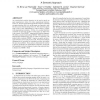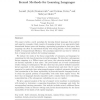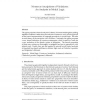311 search results - page 12 / 63 » A Bialgebraic Approach to Automata and Formal Language Theor... |
ATAL
2010
Springer
13 years 9 months ago
2010
Springer
An organizational modeling language can be used to specify an agent organization in terms of its roles, organizational structure, norms, etc. Such an organizational specification ...
IPPS
2000
IEEE
14 years 1 months ago
2000
IEEE
Cellular automata can be used to design high-performance natural solvers on parallel computers. This paper describes the development of applications using CARPET, a high-level prog...
TCS
2008
13 years 8 months ago
2008
This paper studies a novel paradigm for learning formal languages from positive and negative examples which consists of mapping strings to an appropriate highdimensional feature s...
COORDINATION
2009
Springer
13 years 6 months ago
2009
Springer
Abstract. Recent approaches to component-based software engineering employ coordinating connectors to compose components into software systems. For maximum flexibility and reuse, s...
29
Voted
JAPLL
2011
13 years 3 months ago
2011
The paper proposes a formal analysis of a theory of norms resulting from pulling together Anderson’s reduction, the analysis of counts-as, and a novel approach to the formal rep...



